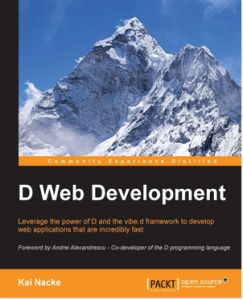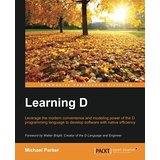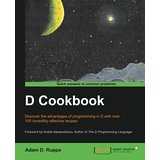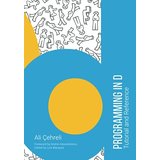A long-time contributor to the D community, Kai Nacke is the author of ‘D Web Development‘ and the maintainer of LDC, the LLVM D Compiler. In this post, he tells the story of how his book came together.
 At the beginning of 2014, I was asked by Packt Publishing if I wanted to review the D Cookbook by Adam Ruppe. Of course I wanted to!
At the beginning of 2014, I was asked by Packt Publishing if I wanted to review the D Cookbook by Adam Ruppe. Of course I wanted to!
The review was stressful, but it was a lot of fun. At the end of the year came a surprising question for me: would I be willing to switch sides and write a book myself? Here, I hesitated. Sure, writing your own book is a dream, but is this at all possible on top of a regular job? The proposed topic, D Web Development, was interesting. Web technologies I knew, of course, but the vibe.d framework was for me only a large unit test for each LDC release.
My interest was awakened and I created a chapter overview, based solely on my experience as a developer and the online documentation of vibe.d. The result came out well and I was offered a contract. It came with an immediate challenge: I should set up a small project plan. How do you plan to write a book?!?
Without any experience in this area, I stuck to the following rules. For each chapter, I planned a little time frame. Each should include at least one weekend, for the larger chapters perhaps even two. I reserved some time for the Easter holiday, too. The first version of the book would therefore be ready at the beginning of July, when I started writing in mid-February.
Even the first chapter showed that this plan was much too optimistic. The writing went off quickly – as soon as I had something I could write about. But experimenting and testing took a lot of time. For one thing, I didn’t have much experience with vibe.d. There were sample programs that I wanted to develop Saturday to write about on Sunday. However, I was still searching for errors on Monday, without having written a single line!
On the other hand, there were still a few rough edges in vibe.d at the time, but I did not want to write that these would be changed or implemented in later versions of the library. So I developed a few patches for vibe.d, e.g. digest authentication. By the way, there were also new LDC releases to create. Fortunately, the LDC team had expanded, so I just took care of the release itself (thanks so much, folks!). The result was, of course, that I missed many of my milestones.
In May, the first chapters came back from the review process. Other content also had to be written, such as the text for the back of the book. In mid-December, the last chapter was finished and almost all review notes on the other chapters were incorporated. After a little Christmas break, the remaining notes were quickly incorporated and the pre-final version of each chapter was created in January. And then, on February 1, 2016, the news came that my book was now published. I’d done it! Almost exactly one year after I had started with the first chapter.
Was the work worth it? In any case, it was a very special experience. Would I do it again? Yes! Right now, I am playing with the idea of updating the book and expanding a chapter. Let’s see what happens…
 rly 2015, Adam Ruppe asked
rly 2015, Adam Ruppe asked  In 2013, Packt Publishing approached me to write
In 2013, Packt Publishing approached me to write  I consider the book
I consider the book 